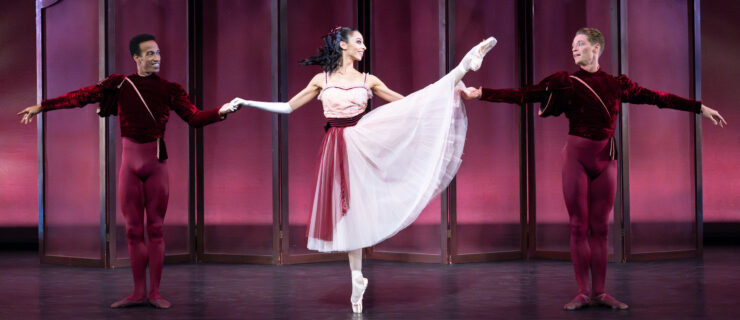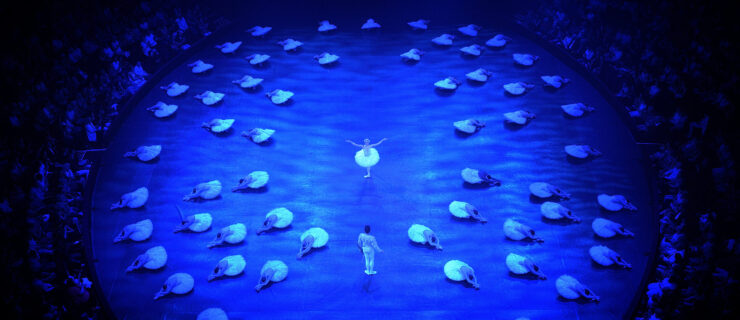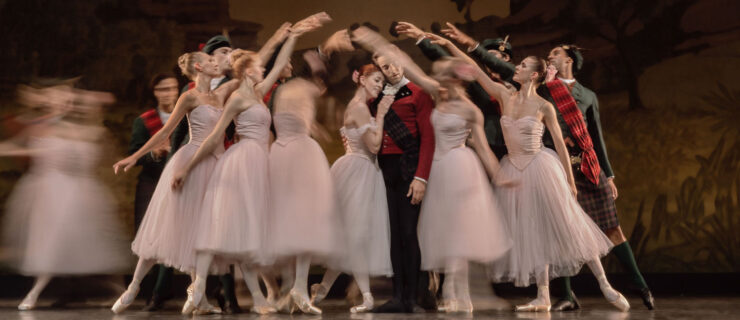Washington, DC: Blossoming Ballet Scene
On a muggy morning in early July, students in The Washington School of Ballet’s level eight class do not get to take it easy. On this day The Washington Ballet’s artistic director, Septime Webre, is teaching. He susses out potentials for the Studio Company, while preparing these pre-professional dancers for the stage. “Think glamorous,” he says before a tendu combination at the barre. “You are wearing false eyelashes and tiaras with rhinestones.” Two dancers from South Africa, one from Japan and one from Argentina will likely join local students to stay the year and train, he says later about the mix of students in the class.
Scenes like this one reveal how Washington, DC and its environs have transformed into a place to which aspiring dancers now flock, not flee. The DC metropolitan area offers a broad selection of high-caliber and diverse training, along with the world’s best companies at The John F. Kennedy Center for the Performing Arts. “Professional dance students used to leave Washington for New York, L.A. or Europe,” says Fabian Barnes, founder and artistic director of the Dance Institute of Washington, home of Washington Reflections Dance Company. “Now there are so many more opportunities to train and perform.”
The Washington Ballet has been around for more than 30 years; Washington Reflections and The Suzanne Farrell Ballet are more recent additions to the city’s cultural panorama. Their rise, coupled with the Kennedy Center’s heightened dance presentation, has given local students ample reason to remain in town, infusing the ballet scene with a fresh jolt of energy.
Webre arrived at The Washington Ballet exactly 10 years ago. Since then, the company’s budget has exploded from $2.8 million in 1999 to $8.5 million this year. Some of that growth has gone to expand the school. At its main branch, The Washington School of Ballet has 450 students enrolled during the year and 300 in its summer intensive program. It added a second school in Anacostia in Southeastern DC, with 200 school year students and 100 in the summer.
When those students are ready to graduate to the next level, they can now audition for The Washington Ballet’s Studio Company. Formed five years ago, it currently employs 8 to 10 dancers who range in age from 18 to 20. They receive weekly stipends and perform in some productions with the main company’s 22 dancers. Last season, Studio Company dancers gave 20 performances on their own at colleges and other venues throughout the region. “The Studio Company gives our students a deeper incentive to stay,” says Webre. “We used to lose our most talented to places like American Ballet Theatre.”
When Fabian Barnes’ Dance Institute of Washington moved into its new home in November 2006, another world of dance opened up to area students. The school trains about 125 students a year, with 30 attending its summer intensive. While the emphasis is on Vaganova training, the school also offers classes in modern and jazz. Barnes says a big draw of the Institute is the opportunity for students to be onstage. They perform at least five times a year at various local venues, such as the National Cathedral and Dance Place.
Dance Institute of Washington’s professional company, Washington Reflections, arrived on the scene in 2002. As a new company trying to carve out a niche in the African-American community, Reflections has experimented with various styles and signature pieces. This year, the company’s six classically trained dancers will perform modern works in New York and Austin, as well as throughout the DC area. The edgy repertoire, choreographed by Barnes and others such as Thaddeus Davis and Christopher Huggins, includes works set to Lauryn Hill, Nine Inch Nails and Duke Ellington.
Many of the dancers are professionals Barnes worked with before and wanted to bring back to the city. “Some of them went to New York, but came back when they couldn’t find their fit,” says Barnes, who danced with the Dance Theatre of Harlem.
Since 1993 the Kennedy Center has hosted a summer intensive with Balanchine muse Suzanne Farrell. Students from around the world come to train with Farrell during her three-week residency, which culminates in a performance. The 30 or so students ages 14 to 18 take two technique classes a day, six days a week. “I try to keep it relatively small so that they all get attention,” says Farrell. “I know their names. If there are 30 students, you can’t teach a class—you have to teach 30 ways because they are all at different points in their lives.”
The students also get to explore the city’s arts and culture scene with trips to museums, historical sites and performances. “She’s one of a kind,” says Meg Kowalski, the Center’s director of dance programming, about Farrell. “She’s brought so much artistry and influence to our stages.”
Farrell’s company at the Kennedy Center dates from 1999, when it debuted as part of the Kennedy Center’s Balanchine festival. Last year The Suzanne Farrell Ballet, composed of nine principals and soloists, stepped up its dedication to Balanchine by creating a Preservation Trust to showcase the choreographer’s lost or rarely seen works. This year the company kicks off its season at the Kennedy Center with Balanchine’s Episodes, Ragtime and Liebeslieder Walzer.
The Kennedy Center has played a key role in all of this dynamic growth. DC’s dance scene swirls around the Center’s nine stages. It’s where most touring companies perform, giving young dancers a chance to see the greatness to which they aspire. Ballet Across America, in June, for example, brought nine companies to the Kennedy Center for three days of performances. That’s in addition to a regular season schedule that featured The Royal Ballet, American Ballet Theatre, New York City Ballet, The Kirov and the Bolshoi Ballet.
Besides presenting such companies, the Center also has a strong education component. The Kennedy Center Ballet Class Series gives 20 to 25 local students a once-in-a-lifetime chance to study alongside the world’s best dancers. Students—who must audition for the highly competitive spots—get to take class onstage at the Opera House during each visiting company’s Kennedy Center run. At press time, the artistic directors of The Joffrey, Kirov and San Francisco Ballet are scheduled to teach. While the series doesn’t culminate in a performance, the students get a taste of professional training and a sampling of different company styles. It’s a peek into company life and a chance to measure themselves against professionals—just one more reason that the nation’s capital is a great place for an aspiring dancer to call home.
Renuka Rayasam is a freelance reporter based in Washington, DC, who has written for U.S. News & World Report and Fortune Magazine. She is trained in ballet, modern and classical Indian dance.





